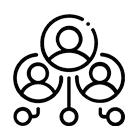Geeta University is dedicated to holistic student development, ensuring that graduates are academically proficient and industry-ready. As one of the best universities in India, we offer specialized programs in Artificial Intelligence (AI), Machine Learning (ML), Cybersecurity, Data Science, and Business Analytics, designed in collaboration with industry leaders to provide practical, future-ready education.
Our commitment to experiential learning is reflected in skill development workshops, hands-on training, and globally recognized certification programs. Students gain real-world exposure through internships, live projects, and industry-integrated learning, bridging the gap between theory and practice.
With a focus on world-class placements, our dedicated placement cell works closely with leading multinational companies, startups, and research institutions to provide students with top job opportunities. Through campus recruitment drives, networking events, and career counseling, we ensure that graduates secure promising careers in top industries.
Geeta University boasts top-notch infrastructure, including state-of-the-art labs, advanced research centers, smart classrooms, and innovation hubs. Our strong corporate partnerships, expert mentorship, and proactive training approach empower students to become leaders, innovators, and problem-solvers in their respective fields.
As one of the best universities in India, we are committed to transforming education and empowering futures, paving the way for students to achieve global success in an evolving job market.

Highest Package

Recruiters

Job Offers
Career 360

Highest Package

Recruiters

Job Offers

Career 360





















70+ Study Programs at Diploma, UG, PG, and Ph.D. Levels
.png)












Professional LinkedIn Session7th May 2025
One Day Workshop on Drone Applications in Agriculture7th May 2025
Expert Talk on Changing World Order and Opportunities for India7th May 2025
2nd International Conference on New Frontiers of Pharmaceutical Research02th April 2025
Hackforge'2501th May 2025 to 02th May 2025
Bizz Fiesta 2K25 (Season 8)30th April 2025
Educational Visit30th April 2025
Visit by Naveen Creative Academy Students29th April 2025
International Dance Day29th April 2025
3RD INTERNATIONAL CONFERENCE ON COMPUTATIONAL SCIENCE & MANAGEMENT (ICCSM 2025)25th & 26th April 2025
GU Topper CeremonyApril 12, 2025
Convocation of Geeta University and Geeta Group of Institutions 2K25March 22, 2025
Holi CelebrationMarch 13, 2025
Annual Fest SANGRILA 2K25March 21 & 22, 2025
3rd Annual Sports MeetMarch 07 & 08, 2025
Expert Session on E-Filing of Income Tax ReturnLearn step-by-step guidance on e-filing your income tax return.
Management CarnivalShowcasing creativity, leadership, and teamwork in dynamic management events.
ChristmasCelebrating the warmth, joy, and traditions of Christmas together.
63rd National Pharmacy Week 2024Promoting healthcare awareness and celebrating contributions of pharmacy professionals.
Hands-on Workshop on Ex-pharm SoftwareEnhancing practical understanding of animal experimentation using Ex-pharm tools.
National Symposium on MathematicsDiscovering new mathematical approaches and fostering intellectual collaboration.
Scholar Development ProgramDeveloping skills and knowledge to excel in academics and beyond.
FDP on Case Study TeachingInnovative teaching strategies for impactful learning through case studies.
Management CarnivalHonoring academic excellence and celebrating achievements of top performers.
Gu Topper's CeremonyHonoring academic excellence and celebrating achievements of top performers.
Campus Placement Drive by Kollegeapply29th April 2025
Internship Campus Drive by Times of India For MBA, BBA & B.Com Students26.04.2025
Placement Drive of Disha India24th April 2025
Placement Drive of Policy Bazaar09th April 2025
Placement Drive of Profunnel Technologies Private Limited08th April 2025
Placement Drive of Hays Business Solutions11th March 2025
Placement Drive of EPUB Solutions Pvt. Ltd.11th March 2025
Upcoming Event:Placement Drive of ICICI Prudential Life Insurance on 11th March 2025.
Congratulations !GU 8 Students Getting Placed in DHLS Flooring Co.
Congratulations! GU Students Getting Placed in AppSquadz Software Pvt. Ltd. Company.
Placement Drive of Neptune India Limited for Diploma (ME) on6th March 2025.
Macleods PharmaceuticalsWe extend our best wishes to Gaurav Kumar, Manish Mehra & Saurabh Kumar for their selection in Macleods Pharmaceuticals .
Laborate PharmaceuticalsWe have a Campus Drive of Laborate Pharmaceuticals for the students from B.Pharm of batch 2024 .
Qonevo TechnologiesWe have a Campus Drive of Qonevo Technologies for the students from B.Tech (CSE), MCA & MBA of batch 2024 .
Corrit ElectricWe have a Campus Drive of Corrit Electric for the students from MBA of batch 2024 .
Corrit ElectricWe have a Campus Drive of Corrit Electric for the students from BBA, BFSI, B.Com, BCA & MBA of batch 2024 & 2025 .
IFCI Financial Services LtdWe have an Internship Drive of IFCI Financial Services Ltd. for the students from BBA, B.Com & MBA of batch 2025 & 2026 .
Knowledge SquardWe extend our best wishes to Nitya Bansal, Palak, Samya & Simran Chauhan for their selection in Knowledge Squard.
Elegant Design SolutionsWe extend our best wishes to Gautam, Taru Tasser & Vishal Kumar for their selection in Elegant Design Solutions.
IBR LiveWe extend our best wishes to Anker Tomar, Khushi & Mayank Chhabra for their selection in IBR Live.
RAT ForensicsWe have an Internship Drive of RAT Forensics for the students from B.Sc & M.Sc (Forensic Science) of batch 2025 .
Motilal Oswal Financial ServicesWe extend our best wishes to Karan Malhotra & Lucky for their selection in Motilal Oswal Financial Services.
Jindal ITFWe have a Campus Drive of Jindal ITF, an OPJindal Group for the students from B.Tech (Mechanical & Civil) of batch 2024 .
Group, An Immigration CompanyWe have an Internship Drive of Charlie Group, An Immigration Company for the students from BBA, B.Com & MBA of batch 2025 & 2026 .
RAT ForensicsWe extend our best wishes to Ajay for his selection in RAT Forensics.
Medrific BiotecWe have a Campus Drive of Medrific Biotec for the students from B.Pharm of batch 2024 .
JungleWorks, ChandigarhWe extend our best wishes to Raj Jaiswal & Garvita for their selection in JungleWorks, Chandigarh.
Central ParkWe extend our best wishes to Anuraj Sharma, Suresh & Aman Ansari for their selection in Central Park.
Haryana Test House LaboratoriesWe extend our best wishes to Dhiriti, Sumit Maan & Ritik for their selection in Haryana Test House Laboratories.
Ken ResearchWe have a Campus Drive of Ken Research for the students from MBA of batch 2025 .
.png)
We believe that financial constraints should not limit access to quality education. At Geeta University, we offer scholarships based on:
























